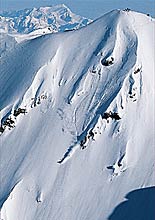Expose Yourself

You’re ripping down a big mountain line in perfect powder. You bang a left, pop off a spine and-smack!-land on bombproof ice. You, and your gear, explode, and you spend the rest of the run in a spin cycle. What went wrong? You didn’t pay attention to what exposure you were on.
When people see big-mountain lines skied in movies, they tend to focus on how fast or how well the skier is skiing. But tackling high-peak terrain is as much about picking the right place to ski as it is about getting to the bottom of it.Think sunlight: The more sunshine a face gets, the more variable the conditions will be. South- and west-facing slopes see the most direct sunlight while north- and east-facing slopes are in shade most of the day. The more sun exposure, the denser the snow becomes. The more the snowpack melts, the more susceptible it is to freezing: That means you get boilerplate. Conversely, snow that doesn’t melt retains its crystalline structure and champagne powder quality.
If you’re climbing to ski, prepare by getting the morning weather and avalanche reports. Use a compass to choose the exposure you want to ski. Probe the snow and dig a pit to make sure you’re right, then study your line before you drop in. If you’re riding the lift, look for pine forests-more common to northern slopes. Southern exposures have either aspens or willows or no major vegetation at all.
Seth Morrison
Age: 30
Height: 5 feet 10 inches
Weight: 155 pounds
Home Area: Vail, CO
Accomplishments: 2002 ESPN Skier of the Year; star of nine Matchstick Productions films; widely considered to be the top big mountain skier in the game.
Worst Learning Experience: “On November 30, 1996, I was shooting an ad for K2 at Snowbird. I had my race stock Salomon “green spring” bindings maxed at a 17 DIN so my skis wouldn’t come off. I was straight-lining on the last run of the day and hit an ice chunk or a rock under the light snow. My ski wrenched sideways, but the binding didn’t release. It shattered my left ankle, and I missed the whole season. I’d never missed a season before, and that one turned out to be one of Colorado’s best. Since then I start off every season with my DIN on 9 and work my way up to 13. And I never twist them up higher than 13.”